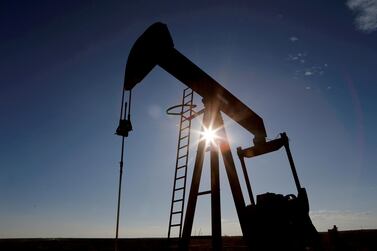After something of a surprise last month, when it kept production levels frozen, the Opec+ group again wrongfooted the market on Thursday. General expectations were for an extension of quotas. Instead, the alliance decided to ease cuts, an important step on the road to recovery.
Despite hopes that there would be no production increases, and a technical committee meeting on Tuesday’s reduction of demand growth forecasts from 5.9 million barrels per day to 5.6 million bpd this year, Brent crude actually rose by 1.4 per cent on the news of the final arrangement.
The idea now is to add 350,000 bpd in both May and June and 441,000 bpd in July, although monthly additions could be up to 500,000 bpd.
Saudi Arabia will also gradually ease its voluntary extra cut of 1 million bpd. That will bring 2.1 million bpd or more back to the market over the next three months.
If Opec+ can adhere to this plan – it has two more monthly meetings to change course before July – its cuts will amount to 5.8 million bpd from July, back in line with the original plan from last April. That would be quite an achievement, given the chaos in the intervening period.
A couple of jolts this year – the Texas freeze in February and the Suez Canal blockage last month – have had only transient effects on the market.
The demand picture is mixed, with a new wave of Covid-19 cases worldwide, particular concerns in Brazil and India, a slow European vaccine campaign and the danger of new virulent strains with high transmission rates that pose a greater risk to younger people.
On the other hand, refinery runs are returning to normal, except for jet fuel. US stocks are essentially back to pre-pandemic levels and American road and air travel appears to be recovering over the Easter holidays.
Forecasts suggest a mild worldwide deficit of oil supplies even in the second quarter of this year, traditionally a period of weak demand.
Higher domestic consumption in Saudi Arabia during summer will give the kingdom room to boost output without increasing exports much.
Despite its heavy dose of environmental objectives, US President Joe Biden’s proposed $2.3 trillion infrastructure plan will be supportive of petroleum consumption over the medium term but bearish in the long term.
An increase in production was becoming harder to resist, whatever the demand signals. It was hard to continue handing out moderate increases to Russia and Kazakhstan, and tolerating Iraqi overproduction while Saudi Arabia continued to bear the burden of extra cuts and the UAE was keen to make more use of its expanded capacity.
Russia has been exceeding its quota and did so by about 165,000 bpd in February. March exports fell sharply and if it keeps production steady, it will be compliant by April.
Deputy Prime Minister Alexander Novak said it will gain 114,000 bpd between May and July, which is true in terms of its quotas. More likely, it will continue to push the limits.
Opec member Iran, which is not part of the deal, managed to boost its exports significantly this year in defiance of US sanctions. Indirect talks between Iran and the other parties to the 2015 nuclear deal commence tomorrow in Vienna, Opec’s usual home.
Given the tension, some of Tehran's neighbours will not be keen on it regaining market share should the negotiations bear fruit, while their output remains capped.
Opec also had to bear in mind the quickening pace of drilling in the US that will, after a lag of a few months, lead to higher production. India has been complaining that high oil prices will crimp its demand. The US is uneasy about the sharp rise in prices in February and early March.
Although the deal framework would keep production constant after July until the end of next April, that may not be realistic.
Recovering demand will require Opec+ to continue adding crude, even if it pauses in some months when problems strike.
What should Opec+ look out for from this point? The pandemic and the associated issues of international travel, vaccination, new infection waves and lockdowns remain pivotal.
The organisation should be proactive to meet anticipated demand – acknowledging how difficult forecasts remain – rather than risk further price spikes and the revival of rivals.
Not as essential, but also significant, is the level of supply outside the deal – most importantly from volatile Libya, sanctioned Iran and price-sensitive US shale.
The structure of oil futures prices is also important. They are now in backwardation, with prices for future delivery lower than prompt, a structure that indicates the market is relatively tight.
Opec prefers this as it encourages the draining of surplus stocks and deters its competitors, tight oil drillers in the US, from hedging output.
There is still a long way to go towards a semblance of normality, both in oil markets and the world at large. However, this production increase gives some confidence of heading in the right direction – hence the gain in prices as it was announced.
Down the road lurks another difficult conversation, on a future realignment of quotas as growing capacity in some members confronts depletion in others. For now, the next few steps are mapped out.
Robin Mills is chief executive of Qamar Energy and author of The Myth of the Oil Crisis







